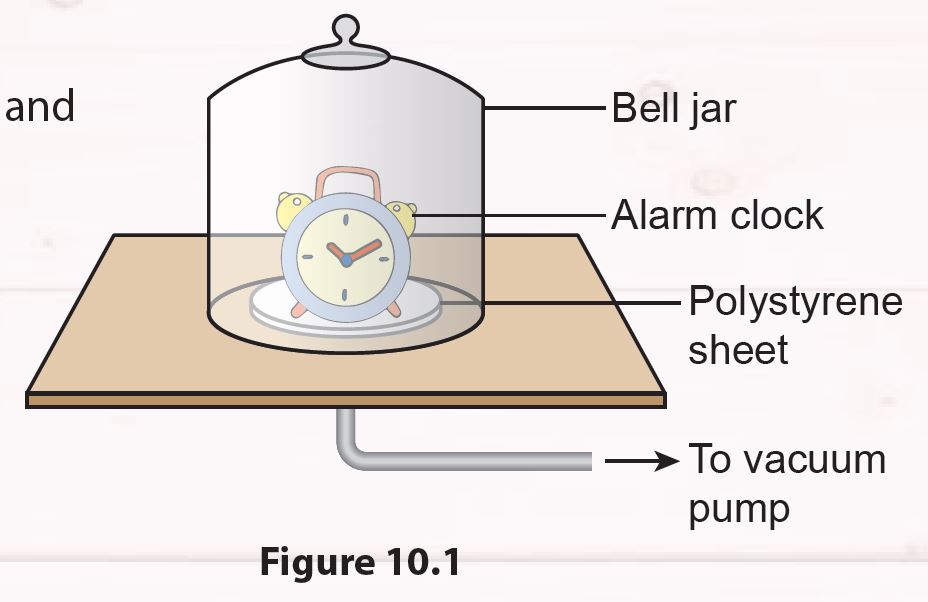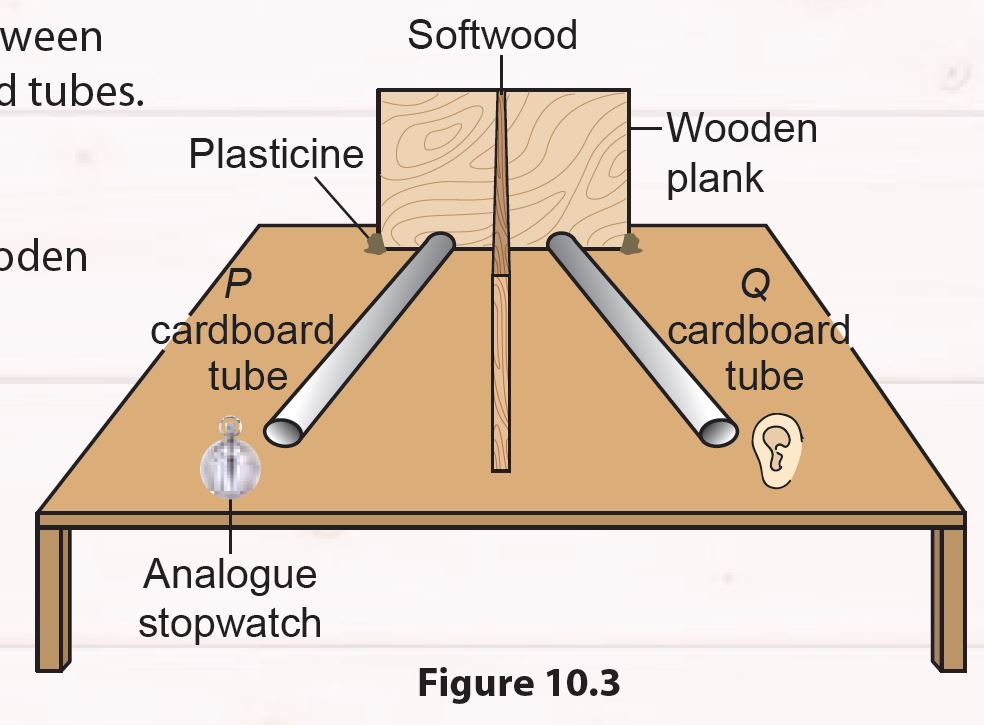Activity 10.1:
Aim: To study the characteristics of sound waves.
(A) Propagation
(i) Requires a medium to propagate
Apparatus: Bell jar, polystyrene sheet, alarm clock and vacuum pump
Instruction
1. Set up the apparatus as shown in Figure 10.1.
2. Activate the alarm clock and listen to the sound produced.
3. Then, turn on the vacuum pump to suck the air out.
4. Record your observation.

(ii) Propagate at different speeds in different medium
Materials: Water and flour
Apparatus: Plastic container and alarm clock
Instruction
1. Prepare three plastic containers that are filled with air, water and flour respectively.
2. Place the empty plastic container (filled with air) tightly onto the table and place your ear onto the container (Figure 10.2).
3. Ask your friend to activate the alarm clock at the end of the table and listen to the sound produced.
4. Repeat steps 2 and 3 using the containers filled with water and flour. Compare the loudness of the sound produced.

Questions
1. What is observed when the vacuum pump is turned on? Give an inference for your observation.
2. Arrange the containers filled with air, water and flour in order of increasing loudness.
Answer:
(A)
1. Sound is not heard because there is no medium for sound to propagate.
2. Air, water and flour
Aim: To study the characteristics of sound waves.
(A) Propagation
(i) Requires a medium to propagate
Apparatus: Bell jar, polystyrene sheet, alarm clock and vacuum pump
Instruction
1. Set up the apparatus as shown in Figure 10.1.
2. Activate the alarm clock and listen to the sound produced.
3. Then, turn on the vacuum pump to suck the air out.
4. Record your observation.

(ii) Propagate at different speeds in different medium
Materials: Water and flour
Apparatus: Plastic container and alarm clock
Instruction
1. Prepare three plastic containers that are filled with air, water and flour respectively.
2. Place the empty plastic container (filled with air) tightly onto the table and place your ear onto the container (Figure 10.2).
3. Ask your friend to activate the alarm clock at the end of the table and listen to the sound produced.
4. Repeat steps 2 and 3 using the containers filled with water and flour. Compare the loudness of the sound produced.

Questions
1. What is observed when the vacuum pump is turned on? Give an inference for your observation.
2. Arrange the containers filled with air, water and flour in order of increasing loudness.
Answer:
(A)
1. Sound is not heard because there is no medium for sound to propagate.
2. Air, water and flour
(B) Sound can be reflected and absorbed:
Apparatus: Cardboard tube, analogue stopwatch, plasticine, wooden plank, metal sheet, softwood and towel
Instruction
1. Set up the apparatus as shown in Figure 10.3 and make sure there is a distance of about 5 cm between the wooden plank and the end of the cardboard tubes.
2. Move tube Q until you can hear the ticking stopwatch clearly.
3. Without moving tubes P and Q, replace the wooden plank with a metal sheet followed by a towel.
Compare the loudness of the ticking of the stopwatch.
4. Record all your observations.

Questions
1. Based on your observation, which surface is a
(a) good absorber of sound?
(b) good reflector of sound?
2. Predict whether a glass sheet is a good absorber or reflector of sound.
Answer:
B
1. (a) Towel
(b) Metal sheet
2. Glass is a good reflector of sound.
Apparatus: Cardboard tube, analogue stopwatch, plasticine, wooden plank, metal sheet, softwood and towel
Instruction
1. Set up the apparatus as shown in Figure 10.3 and make sure there is a distance of about 5 cm between the wooden plank and the end of the cardboard tubes.
2. Move tube Q until you can hear the ticking stopwatch clearly.
3. Without moving tubes P and Q, replace the wooden plank with a metal sheet followed by a towel.
Compare the loudness of the ticking of the stopwatch.
4. Record all your observations.

Questions
1. Based on your observation, which surface is a
(a) good absorber of sound?
(b) good reflector of sound?
2. Predict whether a glass sheet is a good absorber or reflector of sound.
Answer:
B
1. (a) Towel
(b) Metal sheet
2. Glass is a good reflector of sound.